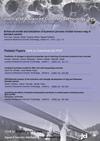温度对水泥浆体和混凝土早期弹性模量演化的影响
IF 2
4区 工程技术
Q3 CONSTRUCTION & BUILDING TECHNOLOGY
引用次数: 0
摘要
温度对胶凝材料水化的影响传统上是用成熟度概念和阿伦尼乌斯定律来建模的。这种方法产生了一个单一的材料属性,称为表观活化能(Ea),它描述了整个温度依赖性。实验确定Ea引发了争议,例如不同的性能(如抗压强度、抗拉强度、e -模量)是否表现出不同的Ea,整个水化过程是否存在单一的Ea值,或者水泥浆体和混凝土是否具有相同的Ea。此外,通过弹性模量测量Ea的研究确实很少,可能是由于早期测量该性能的实验挑战。研究了温度对水泥浆体和混凝土弹性模量演化的影响。在三种不同的等温条件下,使用EMM-ARM(通过环境响应法测量弹性模量)方法对每种材料的单一混合物进行了测试。利用得到的弹性模量演化曲线,分别用“速度法”和“速度导数法”两种传统计算方法推导出弹性模量演化曲线。结果表明,两种材料的弹性模量演化最初呈现恒定的Ea,不受温度和水化发展的影响,这是经典Arrhenius定律所预测的。然而,随着水化过程的进行,活化能对温度和水化水平都表现出明显的依赖性。水泥浆体和混凝土在水化过程中始终表现出不同的Ea值,混凝土的Ea值较高。利用等效年龄概念对不同实验弹性模量演化曲线进行叠加,得到了接近完美的叠加,增强了等效年龄概念应用于弹性模量演化的有效性。本文章由计算机程序翻译,如有差异,请以英文原文为准。
Influence of Temperature in the Early-age Elastic Modulus Evolution of Cement Pastes and Concrete
The influence of temperature on the hydration of cementitious materials has been traditionally modelled using the maturity concept and Arrhenius law. This approach yields a single material property, called apparent activation energy (Ea), that describes the whole temperature dependence. Determining Ea experimentally has sparked controversy, such as whether the different properties (e.g., compressive strength, tensile strength, E-modulus) exhibit different Ea, whether a single Ea value exists for the entire hydration process, or whether cement paste and concrete possess the same Ea. Furthermore, studies measuring Ea from elastic modulus measurements are truly scarce, likely due to experimental challenges with measuring this property at early-ages. This work investigated the influence of temperature on the elastic modulus evolution of cement paste and concrete. A single mix for each material was tested with the EMM-ARM (Elasticity Modulus Measurement through Ambient Response Method) methodology under three different isothermal conditions. The resulting elastic modulus evolution curves were used to derive Ea evolution curves from two traditional computation methods: the ‘speed’ method and the ‘derivative of speed’ method. Results showed that the elastic modulus evolution of both materials initially presented a constant Ea, independent of temperature and hydration development as preconized by the classical Arrhenius law. However, as hydration progressed to later stages, the activation energy exhibited evident dependencies on both temperature and hydration levels. Cement paste and concrete consistently exhibited different Ea values throughout hydration, with concrete having higher values. The use of the Ea curves to superimpose the different experimental elastic modulus evolution curves by means of the equivalent age concept led to near-perfect superpositions, strengthening the validity of this concept when applied to elastic modulus evolution.
求助全文
通过发布文献求助,成功后即可免费获取论文全文。
去求助
来源期刊

Journal of Advanced Concrete Technology
工程技术-材料科学:综合
CiteScore
3.70
自引率
10.00%
发文量
45
审稿时长
3.5 months
期刊介绍:
JACT is fast. Only 5 to 7 months from submission to publishing thanks to electronic file exchange between you, the reviewers and the editors.
JACT is high quality. Peer-reviewed by internationally renowned experts who return review comments to ensure the highest possible quality.
JACT is transparent. The status of your manuscript from submission to publishing can be viewed on our website, greatly reducing the frustration of being kept in the dark, possibly for over a year in the case of some journals.
JACT is cost-effective. Submission and subscription are free of charge . Full-text PDF files are available for the authors to open at their web sites.
Scope:
*Materials:
-Material properties
-Fresh concrete
-Hardened concrete
-High performance concrete
-Development of new materials
-Fiber reinforcement
*Maintenance and Rehabilitation:
-Durability and repair
-Strengthening/Rehabilitation
-LCC for concrete structures
-Environmant conscious materials
*Structures:
-Design and construction of RC and PC Structures
-Seismic design
-Safety against environmental disasters
-Failure mechanism and non-linear analysis/modeling
-Composite and mixed structures
*Other:
-Monitoring
-Aesthetics of concrete structures
-Other concrete related topics
 求助内容:
求助内容: 应助结果提醒方式:
应助结果提醒方式:


